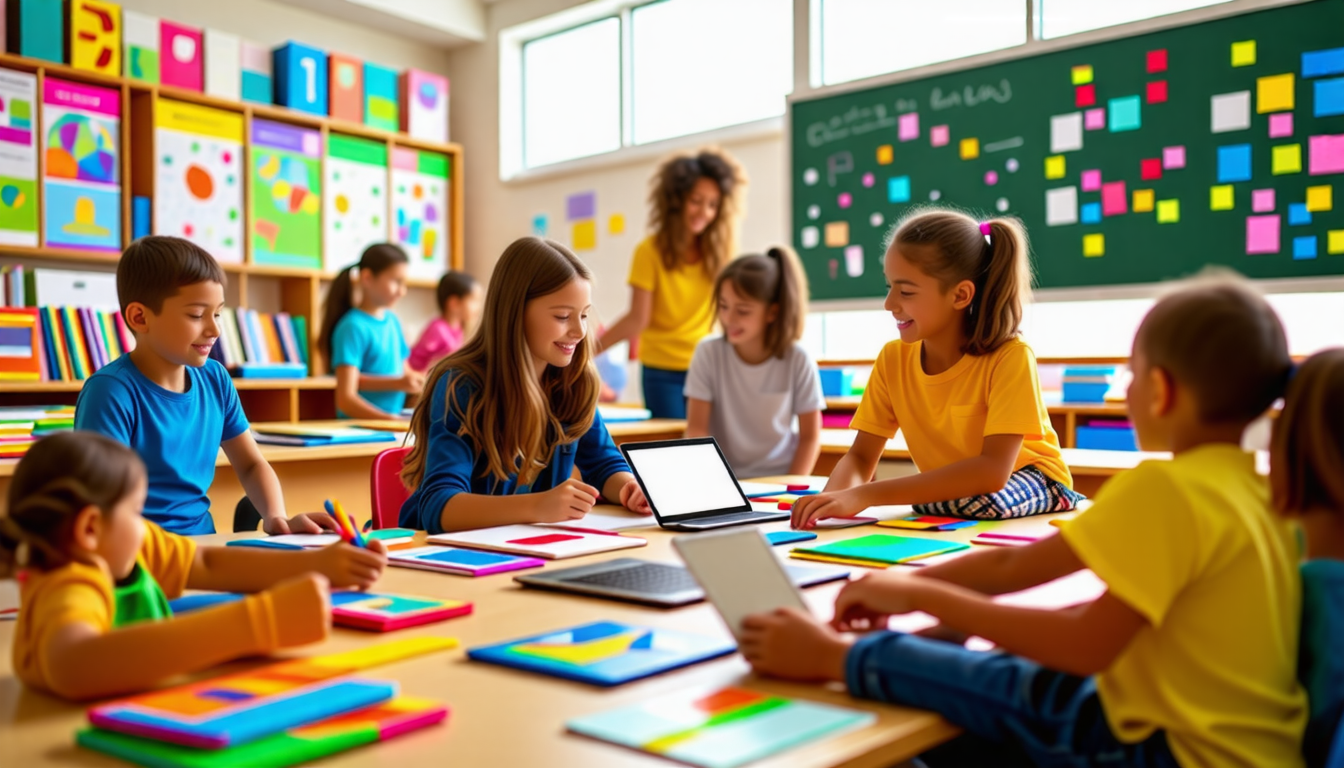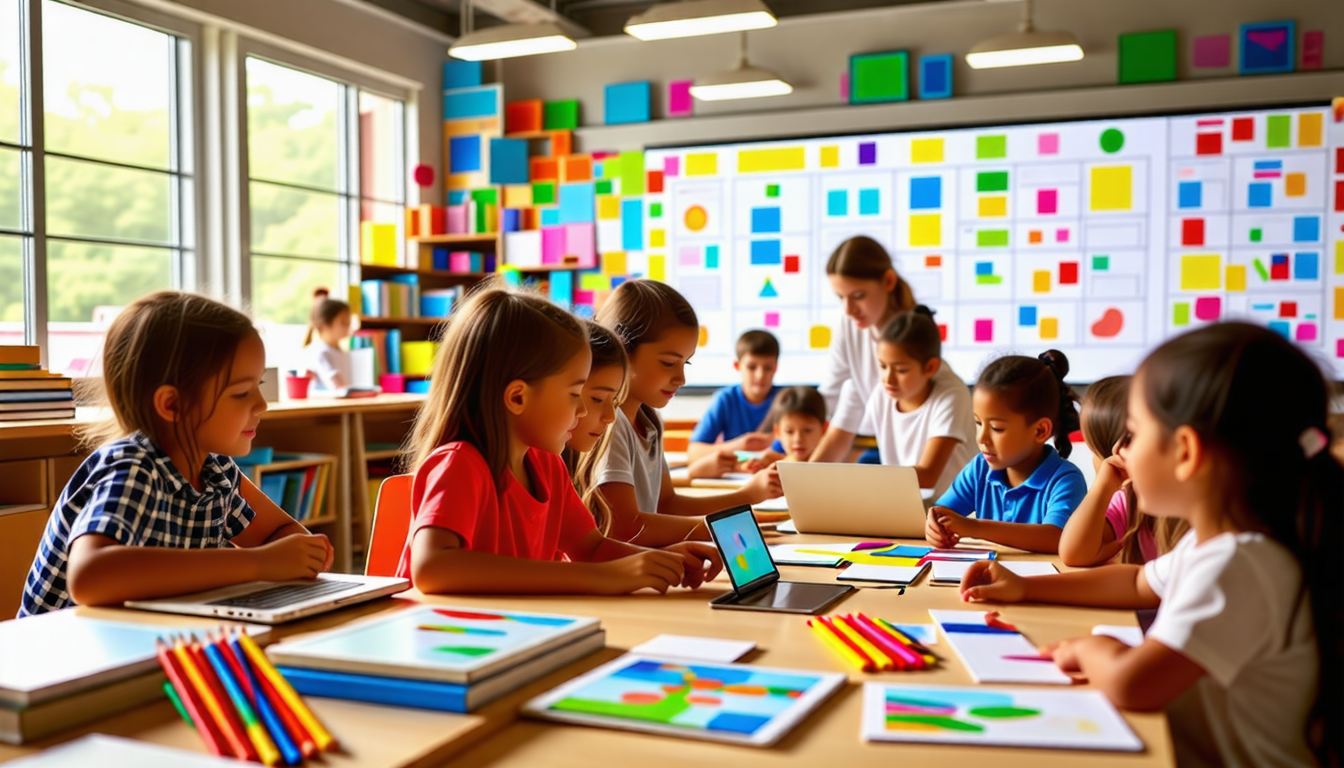|
IN BRIEF
|
In today’s rapidly evolving educational landscape, identifying the most effective tools for enhancing children’s learning is crucial. With the integration of technology in the classroom, both educators and parents are presented with a wealth of resources designed to support cognitive development and foster a love for learning. From interactive storytelling apps to hands-on educational games, the options are virtually limitless. These digital tools not only make education more engaging but also provide opportunities for personalized learning experiences. By leveraging tools that resonate with children’s unique learning styles, we can create an environment that encourages exploration and creativity. As we explore the landscape of educational resources, it becomes clear that a balanced approach, incorporating both traditional methods and modern technologies, is key to unlocking each child’s full potential.

In the modern educational landscape, various tools have emerged to significantly bolster children’s learning processes. These tools range from traditional methods to innovative technologies, each tailored to support different aspects of a child’s development.
Engaging Educational Apps
Among the myriad resources available, educational apps have made a remarkable impact. They provide an interactive platform that encourages children to explore concepts in a fun and engaging manner. For instance, apps such as Grammar Fun and Words with Friends not only entertain but also enhance literacy skills. Similarly, Operation Math: Code Squad introduces mathematical concepts through immersive gameplay, fostering critical thinking and problem-solving abilities.
Interactive Storytelling Platforms
The power of storytelling cannot be overstated in a child’s educational journey. Platforms that offer interactive storytelling experiences engage children’s imaginations while promoting comprehension skills. These tools allow educators to integrate stories with multimedia elements, making lessons more captivating for young learners. The combination of audio, visuals, and text appeals to various learning styles, thereby catering to a diverse classroom.
Virtual Classrooms and Online Learning Environments
With the rise of technology, virtual classrooms have emerged as pivotal learning environments. They provide opportunities for collaboration and social interaction, which are essential for a child’s cognitive and emotional development. These platforms often include discussion forums, interactive assignments, and peer-to-peer learning opportunities. This not only keeps young learners engaged but also supports their social skills as they interact with their peers in a structured setting.
Educational Games for Active Learning
Playing is an essential part of childhood, and integrating educational games into the learning process can significantly enhance retention and understanding. Games that encourage teamwork, critical thinking, and strategy help cultivate essential life skills. For instance, educational games such as board games or scavenger hunts not only make learning enjoyable but also motivate children to engage deeply with the content.
Hands-On Learning Tools
The effectiveness of hands-on learning cannot be overlooked. Materials such as blocks, art supplies, and science kits allow children to explore and experiment in a tactile manner. This type of learning promotes curiosity and critical thinking, enabling students to grasp abstract concepts more concretely. Activities like building structures or carrying out simple experiments provide valuable insights that traditional methods may not consistently offer.
Digital Storytelling and Creative Expression
Digital storytelling is a powerful way to fuse technology with creativity. Children can create their own narratives using various digital tools, encouraging not only creativity but also literacy skills. By transforming their ideas into digital formats, students learn to organize thoughts, enhance their writing skills, and express themselves in unique ways. The process of sharing these stories fosters communication and presentation skills, which are essential in modern education.
Video and Multimedia Resources
Incorporating videos into lessons can drastically change the learning experience. Educational video resources can simplify complex subjects by visually demonstrating concepts and processes. Visual aids can enhance a child’s understanding by presenting information in various ways, helping to cater to different learning styles. Short educational clips are especially effective as they retain children’s attention while providing valuable content.
Learning through Music and Rhythm
Music is an excellent vehicle for learning, as it can significantly enhance memory and retention. Teaching through songs or rhythmic activities has proven to be effective in helping children memorize concepts, such as language rules or mathematical formulas. Utilizing musical elements in education can also improve auditory skills and promote emotional expression.
Collaboration with Peers
Encouraging collaboration among children can significantly enhance their learning experience. Group projects foster teamwork and communication skills, as students learn from each other and share ideas. Collaborative tools, whether physical or digital, provide a platform where children can work together towards a common goal, building their social skills and allowing for diverse perspectives in problem-solving.
Utilizing Classroom Technology
The integration of classroom technology, such as interactive whiteboards and tablets, can enrich the educational experience. These technologies make lessons more dynamic and interactive, allowing educators to present information in engaging ways. They also facilitate individualized learning experiences, with features that cater to each student’s pace and style of learning.
Observational Learning Methods
One of the most effective forms of learning is observation. Children learn a great deal by watching others, whether it be their peers or adults. Incorporating demonstration-based learning allows children to grasp complex ideas by observing procedures and actions in real time. This method also encourages mimicry, helping to solidify learning through practice.
Integration of Physical Activities
Physical activity is not just vital for a child’s health; it plays an essential role in cognitive development, too. Integrating movement into learning can enhance focus and retention. Incorporating physical games or activities that relate to the curriculum helps to establish a connection between body and mind, making learning more effective.
Support from Parents and Caregivers
The role of parents and caregivers is crucial in enhancing children’s learning. Their involvement at home can reinforce the skills taught in school. Providing educational materials, engaging in discussions, and participating in learning activities can create a supportive environment that promotes curiosity and knowledge retention. Resources to help parents can be found in various articles on enhancing children’s cognitive growth, such as this guide.
Embracing Developmentally Appropriate Practices
Understanding developmental stages is key to selecting the right tools for enhancing learning. Embracing developmentally appropriate practices ensures that the methods and resources used align with children’s current abilities and interests. This approach not only enhances efficacy but also nurtures a love for learning, positioning children for long-term academic success.
Assessment and Feedback Mechanisms
Regular assessment and constructive feedback can significantly impact children’s learning experiences. Using various assessment tools that provide immediate feedback helps guide students’ understanding and growth. Formative assessments, such as quizzes or verbal feedback during projects, serve to inform both students and educators on areas of strength and improvement, fostering an environment of continuous learning.
Incorporating Cultural Perspectives and Diversity
Education should reflect the diversity of the world we live in. Incorporating various cultural perspectives not only enriches lessons but also fosters inclusivity among students. Resources that celebrate different cultures can help children respect and appreciate diversity, enhancing social learning and empathy skills.
Continuous Professional Development for Educators
The effectiveness of learning tools is significantly influenced by the educators’ familiarity and comfort with them. Continuous professional development opportunities allow teachers to stay updated on the latest trends and strategies in education. Workshops and training sessions can equip educators with the skills needed to implement effective tools and modify their teaching practices for maximum impact.
Exploring Community Resources
Engagement with local community resources can greatly enhance learning experiences. Libraries, museums, and educational programs provide additional avenues for exploration and enhancement of the curriculum. These resources can offer hands-on learning experiences that go beyond traditional classroom walls, fostering a holistic approach to education.
Prioritizing Child-Centered Learning
At the core of effective educational strategies is the focus on child-centered learning. This approach prioritizes the interests, needs, and developmental stages of each child, allowing for personalized learning experiences. By providing choices and encouraging self-directed learning, educators can cultivate a more motivated and engaged classroom atmosphere.
The Role of Creative Arts
Creative arts play a fundamental role in enhancing children’s learning. Incorporating art, drama, and music into lessons can stimulate creativity and promote self-expression. These activities can serve as powerful tools for developing cognitive and social skills while also making lessons more enjoyable and memorable.
Environment and Learning Spaces
The physical environment in which learning takes place greatly influences children’s engagement and motivation. Creating inviting, flexible, and resource-rich learning spaces encourages exploration and collaboration. Thoughtful arrangement of furniture and resources can create distinct zones for various activities, promoting a sense of ownership in the learning process.
Utilizing Family and Community Engagement
Family and community engagement in educational initiatives bolster children’s learning experiences. Collaborating with families to reinforce classroom learning at home supports continuity and consistency in a child’s education. Programs that involve community members provide real-world learning opportunities and enrich the curriculum with diverse perspectives.
Focus on Emotional and Social Development
An effective learning environment addresses not just academics but also emotional and social development. Integrating emotional intelligence in education aids children in understanding their feelings and those of others. Tools and activities that promote social interactions nurtures these skills, with lasting benefits throughout their lives.
Implementation of Cooperative Learning Strategies
Cooperative learning fosters an atmosphere of collaboration while enhancing children’s learning experiences. Group tasks encourage students to work together, share responsibilities, and build social skills. By learning from one another, children can develop critical thinking and problem-solving skills in a supportive environment.
Encouraging Inquiry and Exploration
Encouraging a culture of inquiry sparks children’s innate curiosity and desire to learn. By fostering an environment where questions are welcomed and exploration is encouraged, teachers can engage students actively in their learning process. This approach aligns well with utilizing tools that promote discovery, ensuring that learning is both meaningful and memorable.
Fostering a Growth Mindset
Instilling a growth mindset in children can have a profound impact on their approach to learning and challenges. By emphasizing the value of effort and perseverance, children learn to embrace setbacks as opportunities for growth. Tools that reinforce this mindset can transform how children view their abilities, ultimately enhancing their resilience and motivation to learn.
In exploring effective tools for enhancing children’s learning, it’s essential to recognize the value of differentiated approaches that cater to individual needs. Digital tools, such as educational apps, interactive games, and storytelling platforms, provide engaging mediums that can make learning both fun and impactful. Incorporating hands-on activities, from arts and crafts to puppet shows and dance, can significantly enrich the educational experience. Moreover, utilizing resources like journals and whiteboards allows children to actively participate in their learning journeys. By leveraging a combination of technological innovations and traditional teaching methods, educators can strive to create an inclusive environment that fosters cognitive growth and nurtures each child’s potential.

Frequently Asked Questions about Enhancing Children’s Learning
What are the most effective tools for enhancing children’s learning?
There are numerous tools that can significantly enhance children’s learning experiences. These include educational apps, interactive games, and d digital storytelling platforms.
How do digital tools facilitate learning?
Digital tools facilitate learning by making education more accessible, interactive, and personalized to meet each child’s unique needs.
What role does technology play in early childhood education?
Technology plays a large role in guiding the development of young children by integrating interactive media that supports creative learning and cognitive growth.
What specific educational apps are recommended for children?
Recommended educational apps include Grammar Fun, Words with Friends, and Operation Math: Code Squad, which are tailored to enhance various learning skills.
What types of activities can be used to support young learners?
Activities such as songs, short video clips, and puppet shows are effective in engaging young children and promoting their learning.
What are the advantages of using hands-on learning tools?
Hands-on learning tools, like blank journals and whiteboards, provide children with physical means to express their learning and keep track of their progress.
Which digital tools empower children in their learning today?
Digital tools that empower children include interactive storytelling apps and virtual classrooms, making learning more meaningful and efficient.
How can observing and assessing enhance children’s learning?
Observing and assessing children’s learning can effectively identify areas for improvement and strengthen developmentally appropriate practices that foster cognitive growth.
What is the most effective way to nurture cognitive growth in children?
The most effective way to nurture cognitive growth is through a blend of engaging educational games and interactive learning experiences designed to captivate their interest.

